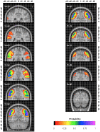Gyri of the human parietal lobe: Volumes, spatial extents, automatic labelling, and probabilistic atlases
- PMID: 28846692
- PMCID: PMC5573296
- DOI: 10.1371/journal.pone.0180866
Gyri of the human parietal lobe: Volumes, spatial extents, automatic labelling, and probabilistic atlases
Abstract
Accurately describing the anatomy of individual brains enables interlaboratory communication of functional and developmental studies and is crucial for possible surgical interventions. The human parietal lobe participates in multimodal sensory integration including language processing and also contains the primary somatosensory area. We describe detailed protocols to subdivide the parietal lobe, analyze morphological and volumetric characteristics, and create probabilistic atlases in MNI152 stereotaxic space. The parietal lobe was manually delineated on 3D T1 MR images of 30 healthy subjects and divided into four regions: supramarginal gyrus (SMG), angular gyrus (AG), superior parietal lobe (supPL) and postcentral gyrus (postCG). There was the expected correlation of male gender with larger brain and intracranial volume. We examined a wide range of anatomical features of the gyri and the sulci separating them. At least a rudimentary primary intermediate sulcus of Jensen (PISJ) separating SMG and AG was identified in nearly all (59/60) hemispheres. Presence of additional gyri in SMG and AG was related to sulcal features and volumetric characteristics. The parietal lobe was slightly (2%) larger on the left, driven by leftward asymmetries of the postCG and SMG. Intersubject variability was highest for SMG and AG, and lowest for postCG. Overall the morphological characteristics tended to be symmetrical, and volumes also tended to covary between hemispheres. This may reflect developmental as well as maturation factors. To assess the accuracy with which the labels can be used to segment newly acquired (unlabelled) T1-weighted brain images, we applied multi-atlas label propagation software (MAPER) in a leave-one-out experiment and compared the resulting automatic labels with the manually prepared ones. The results showed strong agreement (mean Jaccard index 0.69, corresponding to a mean Dice index of 0.82, average mean volume error of 0.6%). Stereotaxic probabilistic atlases of each subregion were obtained. They illustrate the physiological brain torque, with structures in the right hemisphere positioned more anteriorly than in the left, and right/left positional differences of up to 10 mm. They also allow an assessment of sulcal variability, e.g. low variability for parietooccipital fissure and cingulate sulcus. Illustrated protocols, individual label sets, probabilistic atlases, and a maximum-probability atlas which takes into account surrounding structures are available for free download under academic licences.
Conflict of interest statement
Figures




Similar articles
-
Macroanatomy and 3D probabilistic atlas of the human insula.Neuroimage. 2017 Apr 15;150:88-98. doi: 10.1016/j.neuroimage.2017.01.073. Epub 2017 Feb 4. Neuroimage. 2017. PMID: 28179166
-
Morphological patterns and spatial probability maps of the superior parietal sulcus in the human brain.Cereb Cortex. 2023 Feb 7;33(4):1230-1245. doi: 10.1093/cercor/bhac132. Cereb Cortex. 2023. PMID: 35388402 Free PMC article.
-
Specifying the brain anatomy underlying temporo-parietal junction activations for theory of mind: A review using probabilistic atlases from different imaging modalities.Hum Brain Mapp. 2017 Sep;38(9):4788-4805. doi: 10.1002/hbm.23675. Epub 2017 Jun 13. Hum Brain Mapp. 2017. PMID: 28608647 Free PMC article. Review.
-
Stereotaxic Magnetic Resonance Imaging Brain Atlases for Infants from 3 to 12 Months.Dev Neurosci. 2015;37(6):515-32. doi: 10.1159/000438749. Epub 2015 Oct 7. Dev Neurosci. 2015. PMID: 26440296 Free PMC article.
-
Multisensory and sensorimotor maps.Handb Clin Neurol. 2018;151:141-161. doi: 10.1016/B978-0-444-63622-5.00007-3. Handb Clin Neurol. 2018. PMID: 29519456 Review.
Cited by
-
Mindfulness-Based Cognitive Therapy in Recurrent MDD Patients With Residual Symptoms: Alterations in Resting-State Theta Oscillation Dynamics Associated With Changes in Depression and Rumination.Front Psychiatry. 2022 Mar 7;13:818298. doi: 10.3389/fpsyt.2022.818298. eCollection 2022. Front Psychiatry. 2022. PMID: 35321228 Free PMC article.
-
The parietal lobe evolution and the emergence of material culture in the human genus.Brain Struct Funct. 2023 Jan;228(1):145-167. doi: 10.1007/s00429-022-02487-w. Epub 2022 Apr 22. Brain Struct Funct. 2023. PMID: 35451642 Free PMC article. Review.
-
Motor and sensory neurophysiology in relation to [18F]FDG PET imaging in children with dystonia.Brain Commun. 2025 Jun 18;7(3):fcaf151. doi: 10.1093/braincomms/fcaf151. eCollection 2025. Brain Commun. 2025. PMID: 40585814
-
Characterisation of a novel [18F]FDG brain PET database and combination with a second database for optimising detection of focal abnormalities, using focal cortical dysplasia as an example.EJNMMI Res. 2023 Nov 15;13(1):98. doi: 10.1186/s13550-023-01023-z. EJNMMI Res. 2023. PMID: 37964137 Free PMC article.
-
On the functional brain networks involved in tool-related action understanding.Commun Biol. 2023 Nov 14;6(1):1163. doi: 10.1038/s42003-023-05518-2. Commun Biol. 2023. PMID: 37964121 Free PMC article.
References
-
- Brodmann K. Vergleichende Lokalisationslehre der Großhirnrinde. Leipzig: Barth; 1909.
-
- Duvernoy HM. The Human Brain: Surface, Three-dimensional Sectional Anatomy with MRI, and Blood Supply., 2nd ed New York: Springer; 1999.
-
- Ono M, Kubik S, Abernathey CD. Atlas of the cerebral sulci. Stuttgart New York: Georg Thieme Verlag; 1990.
-
- Bajcsy R, Lieberson R, Reivich M. A computerized system for the elastic matching of deformed radiographic images to idealized atlas images. J Comput Assist Tomogr. 1983;7: 618–625. - PubMed
MeSH terms
Grants and funding
LinkOut - more resources
Full Text Sources
Other Literature Sources

